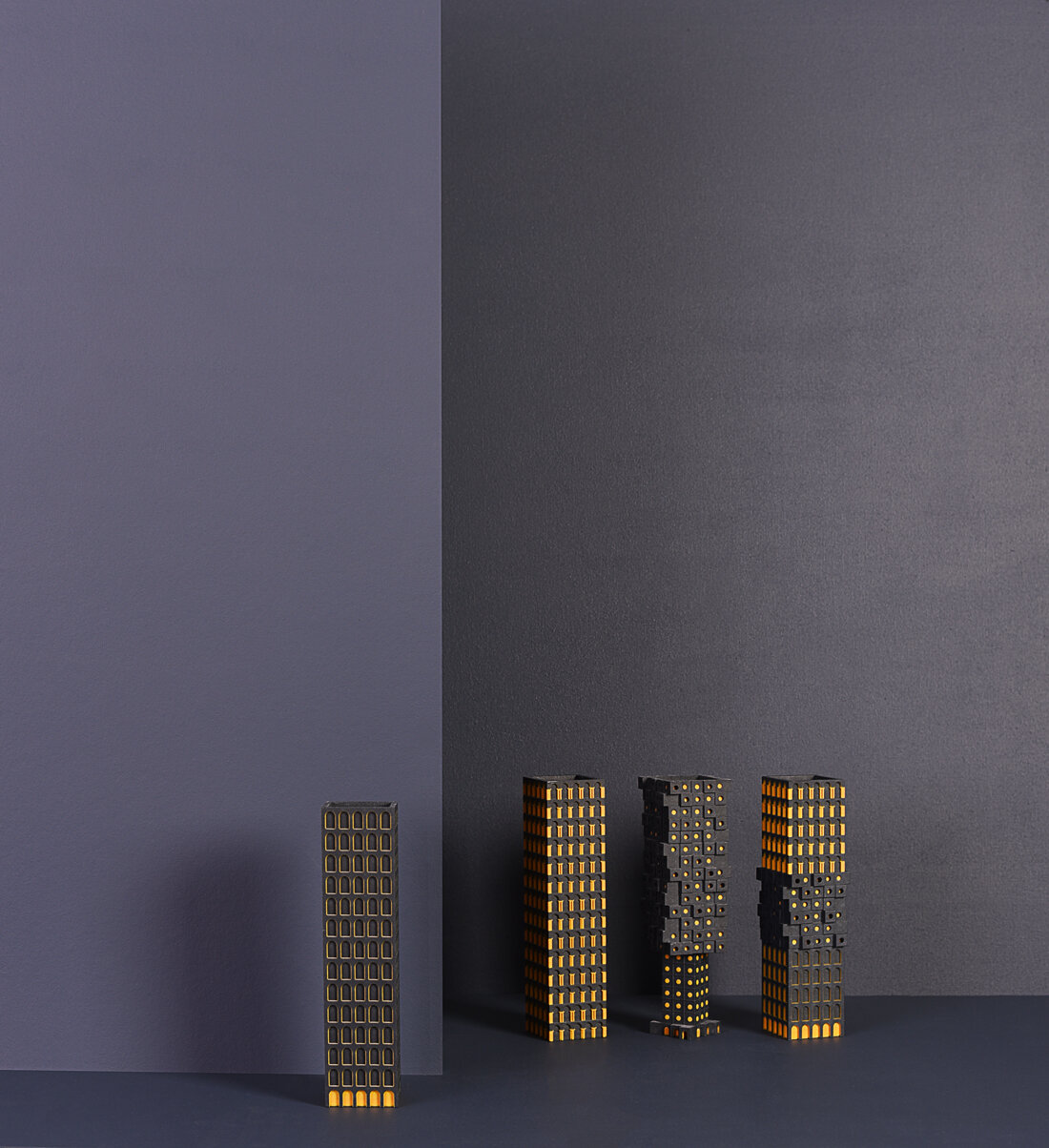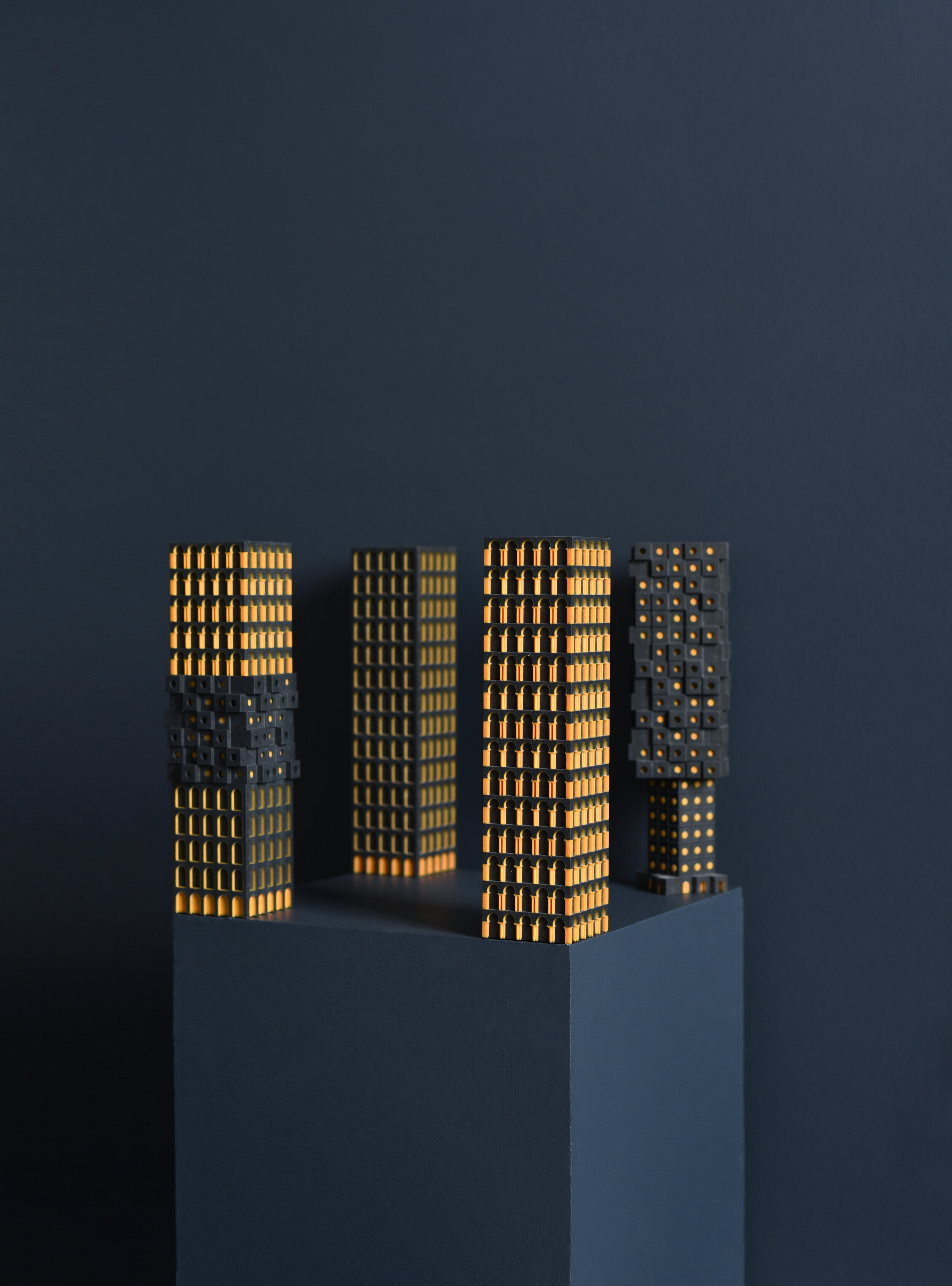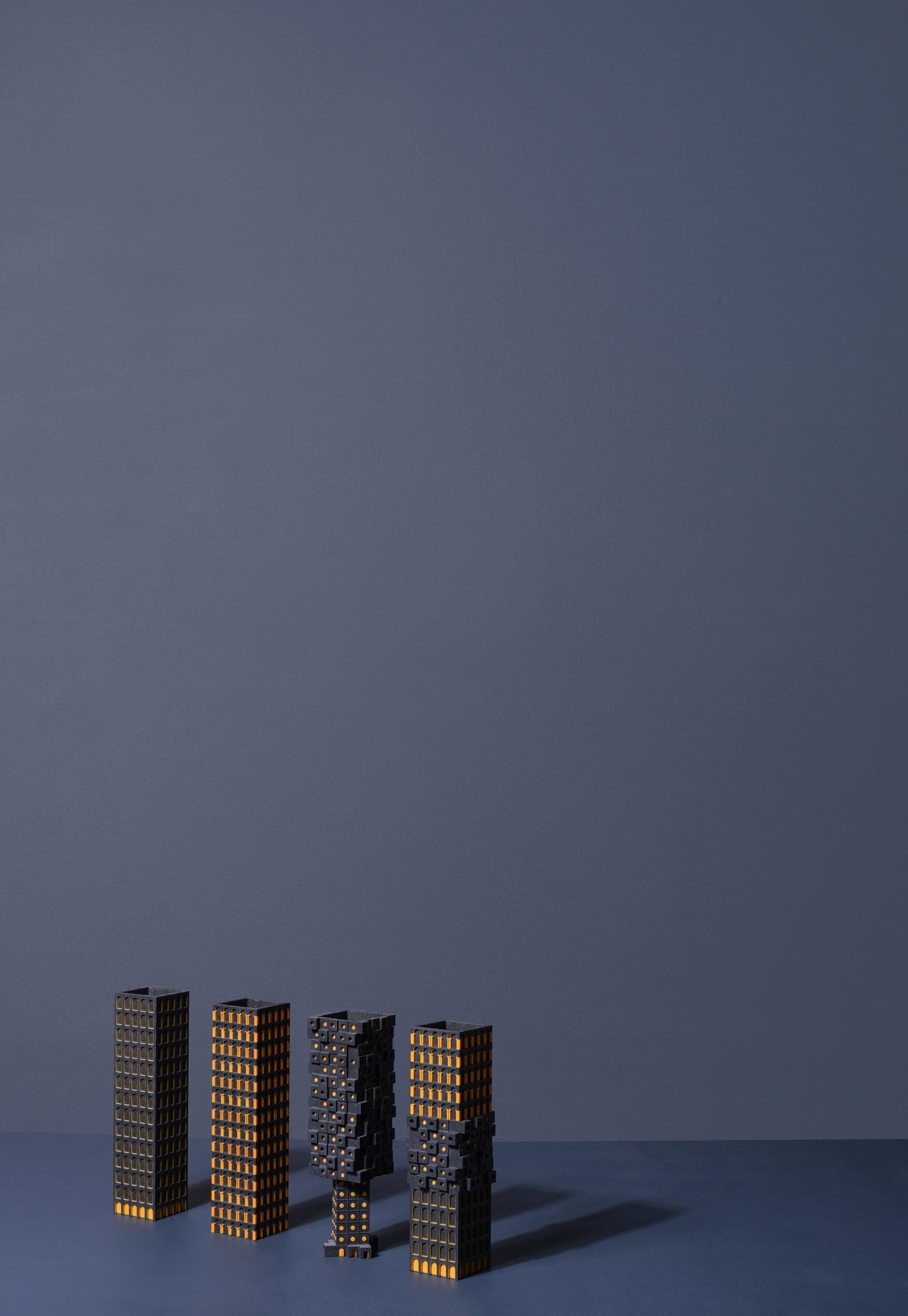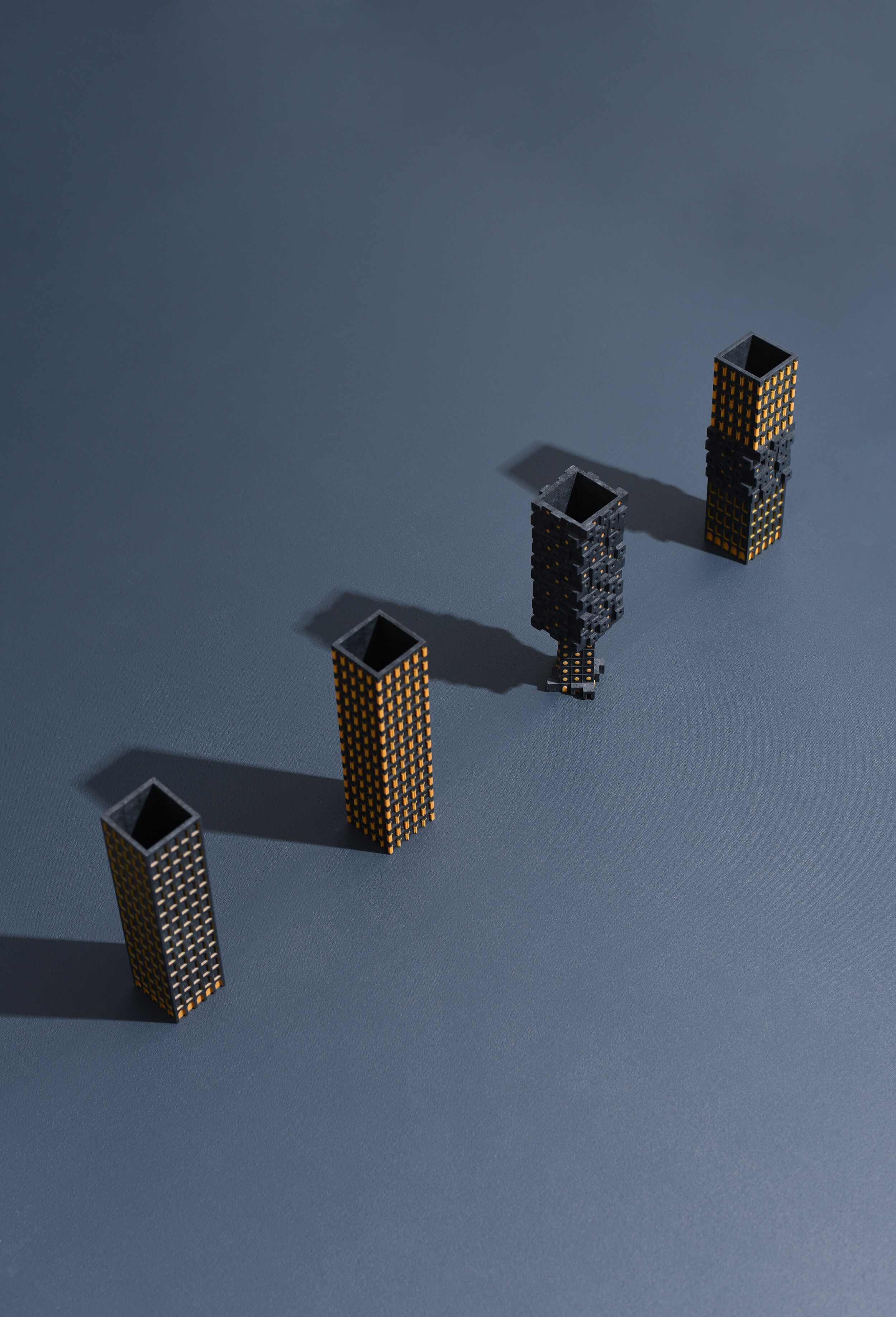0142_Vase collection 01 - The mancunian vase
'Architecture must have something which appeals to the human heart, but even then basic forms, shapes and appearance must be logical. Creative work is expressed in our time as a union of technology and humanity. The role of tradition is that of a catalyst.....’ Kenzo Tange.
SA Studio presents the following emotive collection of vases as an experience based, alternative approach to the question ‘what makes a building/place/object Mancunian in character?’
Backdrop
Whether it’s Manchester’s distinct ‘can-do’ attitude or its robust planning policies post ‘96 and the IRA bombings, we have witnessed an extraordinary transformation of Manchester’s skyline, epitomised by the recent spate of high-rise developments within the city centre. The scale and ambition of such developments have undoubtedly raised the city’s international profile and reach, however, in the midst of this great expansion we fear we may have missed the opportunity to record, re-define, or re-frame Manchester’s contemporary cultural, historical and social identity as physical artifact through such developments. Instead, we see a series of slick, ubiquitous glass towers which no doubt represent great technical innovation in themselves, but speak of little else beyond the name of progress and to serve as a reminder to the growing social and economic inequality within the city. These vases seek to re-evaluate these symbols of progress by referencing and sampling Manchester’s complex diversity and ‘actual’ heritage both past and present, whilst applying a specific local context when drawing inspiration for the collection (sounds simple enough….), in short, let’s make it Manc!
Points of interest
The collection also explores and questions the appropriateness of an ‘accepted’ cultural narrative; the false engineering of an image packaged and re-sold around the world with a healthy dose of cultural whitewashing, nostalgia and romanticism so that the city is seen to be more palatable or attractive to investors. This is not a critique of social and cultural injustices but to understand the fact that our cities, the built environment and what they represent, are not immune to the deeply divisive politics of identity and who owns the narrative, whilst highlighting the fact that a cultural ‘other’ subsists in built form also. We believe the built environment should not be immune to questions pertaining to identity, and until the curry mile or Bugzy Malone is acknowledged in the same light as Tony Wilson himself, The Hacienda or Oasis, the cultural narrative which comes to shape the future of our cities will continue to represent some and marginalise others.
Process
Our design process does not seek to present absolute answers but to put forward an honest response to the fragmented question of Mancunian identity, as a collection of vases to be read as one. Three alternative identities were explored:
vase 01 - host
Mancunian / industrial / Indigenous roots / Ethnocentric
An honest look at Manchester’s industrial, working class heritage taking the simple yet stoic arched window as the cultural cue for the design, firmly rooted in place and deeply symbolic of traditional northern grit. However, is this narrative inclusive and representative of all Mancunians?
Vase 01 acts as the baseline and contextual backdrop for the collection as a whole, referencing its immediate context, there for everyone to see….
Vase 02 - Inherited
Migrant / Indian / Muslim / ancestral Heritage
Vase 02 explores the need for an architectural language which is proportionally representative of Manchester’s ‘actual’ diversity. To try and lend a voice to those who have none, or worse ignored, legitimising their truth.
For many who are not indigenous to a given location there is an adopted and inherited cultural heritage to try and reconcile and navigate. The horse-shoe arch is just one example of a shared cultural heritage without a voice, should it be treated as a parasite invading its host or embraced as an example of the natural evolution of today’s cities and societies? Should an individual or community group have to forsake the traditions they have inherited at the expense of something else?
Vase 03 - appropriated
Global / Education / ’learned’ & appreciated - Metabolists ‘AIR’ / Hyper Density Micro living / cultural appropriation?
Vase 03 in part, is a commentary in the way we have come to consume information as Individuals and a society. Knowledge and information have become so readily available that we have become accustomed to a multitude of global cultural trends, appropriating them for our own purposes.
Vase 03 appropriates the Metabolist ideal of colonising the ‘air’, taking stylistic and practical inspiration from Kisho Kurokawa’s iconic Nagakin ‘plug and play’ prefabricated capsule tower. If policy makers are going to advocate ‘co-living’ and 15m2 micro studios as acceptable forms of living at the expense of traditional homes to meet the cities housing crisis, then there needs to be an honest appraisal of the quality of these places bench-marked against ‘real’ social, economic, sustainable value as compensation for high-density living. Developments should offer tangible customer empowerment, costumisability and a genuine commitment to a zero carbon future. Kurokawa’s vision for micro living was as much ideological as it was technological based on the breakdown of the family unit and predicting the new family system centered on the individual. However, If the family home continues to be an aspiration for many young Mancunians, then the city needs to be honest or rethink its strategy on affordable housing, community living and place-making, or we may end up living in places we don’t want or can’t afford.
vase 04 - identity?
Each identity is distilled and reduced to three fundamental components the arch, horseshoe arch and Nagakin capsule as symbols of shared collective identity and personal meaning.
The final vase is an attempt to reconcile each identity expressed as one. No single identity takes precedence over the other, each being equally relevant depending on context, personal and/or societal meaning.
Materiality & Fabrication
A variety of exciting techniques & materials were explored, including a clay based product, however we found we couldn’t achieve the level of detail required in trying to mimic a fully functioning facade. With this in mind, our research into 3D printing technology steered us towards sandstone because of its ability to simulate high levels of detail, accuracy, versatility in colour and the quality of finish available in recreating different surface textures. Given each vase has its own distinct visual language, the material finish and colour palette was developed as a way of unifying the collection so that they read contextually as one. Several themes were explored, however we felt it was important to ground the collection in its industrial roots but also reflect contemporary society.
Charcoal/black brick texture embracing Manchester’s industrial heritage. Looking towards the PAST.
Gold window frames and reveals to represent a forward thinking, yet slightly confused millennial generation / generation Z. Projecting towards the FUTURE.
Elevation Base Principles
Each vase adopts the same 50 x 50 x 210mm modular base with 15mm subdivisions for floor plates to create a sense of uniformity between each vase and the ability to interchange ‘facades’ between each elevation type.
Side note, whilst there are many positives to be taken from Manchester’s new Residential Quality Guidance, it is a little disheartening to note the limited reference, role and exploration of cultural diversity in its attempt to define Manchester’s ‘uniqueness’ and ‘distinctive character’. Sadly, this lack of diversity and inclusivity is highlighted by the fact that there seems to be little or no representation from BAME backgrounds on either the sounding board or preparation team in collating the document. Given it’s the first document of its kind, we fear it might be an opportunity missed.











